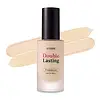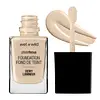Etude House Double Lasting Foundation SPF 35 PA++ Versus Wet n Wild Photo Focus Dewy Liquid Foundation Makeup
What's inside
What's inside
 Key Ingredients
Key Ingredients

No key ingredients
 Benefits
Benefits

 Concerns
Concerns

 Ingredients Side-by-side
Ingredients Side-by-side

Water
Skin ConditioningCyclopentasiloxane
EmollientCI 77891
Cosmetic ColorantTrimethylsiloxysilicate
EmollientCyclohexasiloxane
EmollientTitanium Dioxide
Cosmetic ColorantCaprylyl Methicone
Skin ConditioningButylene Glycol
HumectantPEG/PPG-18/18 Dimethicone
EmulsifyingCI 77492
Cosmetic ColorantMica
Cosmetic ColorantSodium Chloride
MaskingDimethicone/Vinyl Dimethicone Crosspolymer
Skin ConditioningDisteardimonium Hectorite
StabilisingPolymethylsilsesquioxane
PEG-10 Dimethicone
Skin ConditioningAlumina
AbrasiveAluminum Hydroxide
EmollientPentylene Glycol
Skin Conditioning1,2-Hexanediol
Skin ConditioningCI 77491
Cosmetic ColorantTriethoxycaprylylsilane
Parfum
MaskingCaprylyl Glycol
EmollientGlyceryl Caprylate
EmollientCI 77499
Cosmetic ColorantSimethicone
EmollientXanthan Gum
EmulsifyingDisodium EDTA
Methicone
EmollientBoron Nitride
AbsorbentMethyl Methacrylate Crosspolymer
Tin Oxide
AbrasiveWater, Cyclopentasiloxane, CI 77891, Trimethylsiloxysilicate, Cyclohexasiloxane, Titanium Dioxide, Caprylyl Methicone, Butylene Glycol, PEG/PPG-18/18 Dimethicone, CI 77492, Mica, Sodium Chloride, Dimethicone/Vinyl Dimethicone Crosspolymer, Disteardimonium Hectorite, Polymethylsilsesquioxane, PEG-10 Dimethicone, Alumina, Aluminum Hydroxide, Pentylene Glycol, 1,2-Hexanediol, CI 77491, Triethoxycaprylylsilane, Parfum, Caprylyl Glycol, Glyceryl Caprylate, CI 77499, Simethicone, Xanthan Gum, Disodium EDTA, Methicone, Boron Nitride, Methyl Methacrylate Crosspolymer, Tin Oxide
Water
Skin ConditioningCyclopentasiloxane
EmollientC12-15 Alkyl Benzoate
AntimicrobialDiphenylsiloxy Phenyl Trimethicone
Skin ConditioningPEG-10 Dimethicone
Skin ConditioningIsopentyldiol
HumectantGlycerin
HumectantButylene Glycol Dicaprylate/Dicaprate
EmollientPentylene Glycol
Skin ConditioningSynthetic Fluorphlogopite
Lauryl PEG-10 Tris(Trimethylsiloxy)Silylethyl Dimethicone
EmulsifyingMagnesium Sulfate
Trimethylsiloxysilicate
EmollientPhenoxyethanol
PreservativeDisteardimonium Hectorite
StabilisingVinyl Dimethicone/Methicone Silsesquioxane Crosspolymer
Sorbitan Isostearate
EmulsifyingTriethoxycaprylylsilane
Ethylhexylglycerin
Skin ConditioningParfum
MaskingDisodium EDTA
Dimethicone
EmollientDimethicone/Vinyl Dimethicone Crosspolymer
Skin ConditioningHydrogenated Castor Oil Isostearate
Skin ConditioningCI 77891
Cosmetic ColorantIron Oxides
CI 77492
Cosmetic ColorantCI 77499
Cosmetic ColorantWater, Cyclopentasiloxane, C12-15 Alkyl Benzoate, Diphenylsiloxy Phenyl Trimethicone, PEG-10 Dimethicone, Isopentyldiol, Glycerin, Butylene Glycol Dicaprylate/Dicaprate, Pentylene Glycol, Synthetic Fluorphlogopite, Lauryl PEG-10 Tris(Trimethylsiloxy)Silylethyl Dimethicone, Magnesium Sulfate, Trimethylsiloxysilicate, Phenoxyethanol, Disteardimonium Hectorite, Vinyl Dimethicone/Methicone Silsesquioxane Crosspolymer, Sorbitan Isostearate, Triethoxycaprylylsilane, Ethylhexylglycerin, Parfum, Disodium EDTA, Dimethicone, Dimethicone/Vinyl Dimethicone Crosspolymer, Hydrogenated Castor Oil Isostearate, CI 77891, Iron Oxides, CI 77492, CI 77499
Ingredients Explained
These ingredients are found in both products.
Ingredients higher up in an ingredient list are typically present in a larger amount.
Ci 77492 is also hydrated iron III oxide. It's sole purpose is to give a yellow hue to products.
Iron III oxides are classified as inorganic chemicals for coloring.
Synthetically created Ci 77492 is considered safer than those naturally found. This is because the synthetically created version may contain less impurities. Iron oxides are generally non-toxic and non-allergenic.
Learn more about CI 77492Ci 77499 is also hydrated iron III oxide. It is created from mixing red and black iron oxides. This helps give shades of darkness to a product.
Iron III oxides are classified as inorganic chemicals for coloring.
Ci 77891 is a white pigment from Titanium dioxide. It is naturally found in minerals such as rutile and ilmenite.
It's main function is to add a white color to cosmetics. It can also be mixed with other colors to create different shades.
Ci 77891 is commonly found in sunscreens due to its ability to block UV rays.
Learn more about CI 77891Cyclopentasiloxane, or D5, is a silicone used to improve texture of products and trap moisture.
D5 is considered lightweight and volatile. Volatile means it evaporates quickly after application. Once evaporated, D5 leaves a thin barrier that helps keep skin hydrated.
It is also an emollient. Emollients help soften the skin and prevent water loss. Silicones create a silky texture in products. D5 helps other ingredients become more spreadable.
Studies show D5 is safe to use in skincare products. We recommend speaking with a skincare professional if you have concerns.
Learn more about CyclopentasiloxaneThis ingredient is a silicone used to improve the texture of products and absorb oil. It does not get absorbed into the skin.
Like other silicones, Dimethicone/Vinyl Dimethicone Crosspolymer helps condition the skin by creating a barrier. In this sense, it can act as an emollient and trap moisture in.
This ingredient is a type of elastomer.
Learn more about Dimethicone/Vinyl Dimethicone CrosspolymerDisodium EDTA plays a role in making products more stable by aiding other preservatives.
It is a chelating agent, meaning it neutralizes metal ions that may be found in a product.
Disodium EDTA is a salt of edetic acid and is found to be safe in cosmetic ingredients.
Learn more about Disodium EDTADisteardimonium Hectorite comes from the clay mineral named hectorite. It is used to add thickness to a product.
It can also help stabilize a product by helping to disperse other ingredients.
Hectorite is a rare, white clay mineral.
Learn more about Disteardimonium HectoriteParfum is a catch-all term for an ingredient or more that is used to give a scent to products.
Also called "fragrance", this ingredient can be a blend of hundreds of chemicals or plant oils. This means every product with "fragrance" or "parfum" in the ingredients list is a different mixture.
For instance, Habanolide is a proprietary trade name for a specific aroma chemical. When used as a fragrance ingredient in cosmetics, most aroma chemicals fall under the broad labeling category of “FRAGRANCE” or “PARFUM” according to EU and US regulations.
The term 'parfum' or 'fragrance' is not regulated in many countries. In many cases, it is up to the brand to define this term.
For instance, many brands choose to label themselves as "fragrance-free" because they are not using synthetic fragrances. However, their products may still contain ingredients such as essential oils that are considered a fragrance by INCI standards.
One example is Calendula flower extract. Calendula is an essential oil that still imparts a scent or 'fragrance'.
Depending on the blend, the ingredients in the mixture can cause allergies and sensitivities on the skin. Some ingredients that are known EU allergens include linalool and citronellol.
Parfum can also be used to mask or cover an unpleasant scent.
The bottom line is: not all fragrances/parfum/ingredients are created equally. If you are worried about fragrances, we recommend taking a closer look at an ingredient. And of course, we always recommend speaking with a professional.
Learn more about ParfumPeg-10 Dimethicone is silicone with conditioner and emulsifier properties. It mostly acts as an emollient in skincare and and humectant in haircare.
According to the manufacturer, acidic formulations decrease the stability of this ingredient. It works best in neutral or near neutral formulations.
Pentylene glycol is typically used within a product to thicken it. It also adds a smooth, soft, and moisturizing feel to the product. It is naturally found in plants such as sugar beets.
The hydrophilic trait of Pentylene Glycol makes it a humectant. As a humectant, Pentylene Glycol helps draw moisture from the air to your skin. This can help keep your skin hydrated.
This property also makes Pentylene Glycol a great texture enhancer. It can also help thicken or stabilize a product.
Pentylene Glycol also acts as a mild preservative and helps to keep a product microbe-free.
Some people may experience mild eye and skin irritation from Pentylene Glycol. We always recommend speaking with a professional about using this ingredient in your routine.
Pentylene Glycol has a low molecular weight and is part of the 1,2-glycol family.
Learn more about Pentylene GlycolTriethoxycaprylylsilane is a silicone used to bind and stabilize ingredients.
As an emulsifier, it helps prevent ingredients from separating. This can help elongate the shelf life of products.
Triethoxycaprylylsilane is often used to coat mineral sunscreens ingredients to help give a better feel. It also helps reduce oxidative stress in sunscreens.
Learn more about TriethoxycaprylylsilaneThis silicone is an emollient. Emollients create a thin film on the skin to prevent moisture from escaping.
It is not soluble in water and helps increase water-resistance in products.
According to a manufacturer, it can blend seamlessly with silicone oils, such as Cyclopentasiloxane.
Learn more about TrimethylsiloxysilicateWater. It's the most common cosmetic ingredient of all. You'll usually see it at the top of ingredient lists, meaning that it makes up the largest part of the product.
So why is it so popular? Water most often acts as a solvent - this means that it helps dissolve other ingredients into the formulation.
You'll also recognize water as that liquid we all need to stay alive. If you see this, drink a glass of water. Stay hydrated!
Learn more about Water